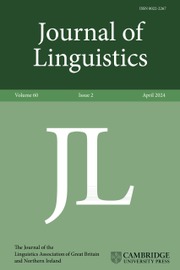Article contents
A Cognitive Grammar account of the semantics of the English present progressive1
Published online by Cambridge University Press: 08 July 2013
Abstract
In this paper, we propose a unified account of the semantics of the English present progressive in the form of a semantic network, basing ourselves on the theoretical principles and analytical tools offered by the theory of Cognitive Grammar, as laid out by Langacker (1987, 1991). The core meaning of the English present progressive, we claim, is to indicate epistemic contingency in the speaker's immediate reality. It thus contrasts with the simple present, which is associated with situations that are construed as structurally belonging to reality. On the basis of a study of the Santa Barbara Corpus of spoken American English, an inventory has been made of the more specific uses of the present progressive, temporal as well as modal. It is shown that each of these uses can be derived from this basic meaning of contingency in immediate reality via a set of conceptual branching principles, in interaction with elements in the context.
Information
- Type
- Research Article
- Information
- Copyright
- Copyright © Cambridge University Press 2013
Footnotes
Parts of the research for this paper have already been reported in De Wit & Brisard (2009). We wish to thank Ron Langacker and three anonymous Journal of Linguistics referees for their useful comments on earlier versions of this text. Thanks are also due to the Research Foundation – Flanders (FWO) for its financial support of the first author (grant 4740).
References
REFERENCES
- 27
- Cited by

